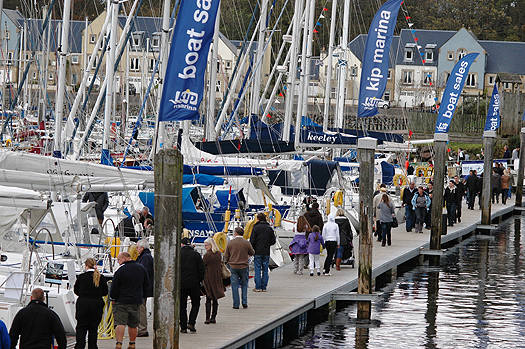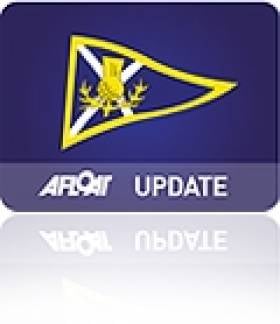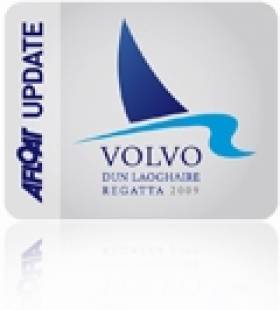Displaying items by tag: Scottish
Julia Bailey Wins 2015 Dragon Scottish Championship
#dragon – Twenty of the top International Dragon crews are gathered in Largs for the 2015 Scottish Mortgage Investment Trust Dragon Scottish Championship and Edinburgh Cup. The regattas, which take place from 27 June to 3 July, have attracted competitors from across the UK and as far afield as Japan.
After three days and five thrilling races the Scottish Mortgage Investment Trust Dragon Scottish Championship concluded on Monday evening with the trophy being awarded to Julia Bailey, Keith Tippell, Will Heritage and Pedro Andrade sailing GBR720 Aimee. Team Aimee arrived in Largs as the defending Edinburgh Cup Champions having won both the overall and Corinthian Edinburgh Cup Trophies in Lymington in 2014 with Julia's husband Graham at the helm. Graham was unable to attend this year's regatta so it was Julia's turn to take the helm and she roped in old friend Pedro to complete their team.
From the opening race Cowes based Julia put her stamp on the regatta showing impressive boat speed and tactical superiority. She won three out of the five races and finished third in another with the only blot on her copybook being an OCS disqualification in race two, when she failed to realise she was on the wrong side of the start line.
Julia's nearest rival was Martin Payne from Cornwall, sailing GBR789 Bear with crew Gillian Hamilton and Donal Small, whose constantly improving scoreline of 4, 2, 2, 1 left them three points behind Julia, but clearly still in firm contention for the coming Edinburgh Cup.
Third place overall and the Corinthian Scottish Championship Trophy, for all amateur crews, was awarded to Patrick Gifford of Angus sailing GBR515 Basilisk with his son Michael and guest crew Martin Spall. Patrick was understandably happy with their achievement as their boat is 29 years young and this was the first time they had raced with Martin in the boat.
For Julia her victory was particularly sweet as she noted, "My Grandfather Machlachlan would have been very proud to know that his granddaughter had won the Dragon Scottish Championship." At the prize giving she also paid tribute to the excellent race management provided by the Scottish Sailing Institute's Race Committee headed by Race Officer Chris Hadden, the outstanding quality of the Clyde's sailing waters and the warm Scottish hospitality that has been extended to the competitors since they arrived at Largs Sailing Club.
On Tuesday morning the fleet will begin racing for the Edinburgh Cup, which was presented to the class by HRH The Duke of Edinburgh in 1949 and is awarded annually to the British Open Dragon Champion. Racing will continue until Friday 3 July with up to six championship races plus a crew's race scheduled.
Joining the fleet for this second part of the competition will be a number of top crews including Gavia Wilkinson-Cox sailing GBR761 Jerboa with Mark Hart and Philip Catmur; Tom Vernon sailing GBR795 Excite with Adam Bowers and Oliver Spensley-Corfield; Mike Budd sailing GBR793 Harry with Mark Greaves and Sam Gardiner; and Ron James sailing GBR633 Fei-Lin's Flirtation with Julia Walsh and Mark Pettit.
The Edinburgh Cup is one of sailing's most prestigious trophies and with four days of top level racing ahead of us it promises to be an extremely close competition. Regular updates, results, photos and videos will be posted to the British Dragon Association Blog and via the British Dragons at Facebook.
Scotland's Class of Champions
#Scottishseries – Tarbert's local sailing hero Ruairidh Scott, who in 2003 won the prestigious Scottish Series Trophy overall returns to his native waters later this week when he competes again in the Brewin Dolphin Scottish Series Regatta.
Now based near Southampton, sail-maker and pro sailor Scott will race in IRC Class 3 as tactician on Grant Gordon's successful south of England based J97 Fever Glenfiddich. While Scott may have aspirations of lifting the premier event's top award for the second time, he and the Fever crew will find themselves up against a tough cross section of past Scottish Series champions, not least the 2011 winning boat, the J97 Jackaroo of Jim and Steve Dick.
In fact there are three J97's competing in the class, top Clyde helm Iain Laidlaw, assisted by sail-maker Chris Owen, finished a close second to the Fever crew at the Savills Kip Regatta, the warm up event a couple of weeks ago.
Though the J97's took 1,2,3 at Kip they might not have it their own way on Loch Fyne – where racing starts Friday and finishes Monday afternoon – as Cork's Anthony O'Leary, the skipper who won the Trophy in 2004 and 2006, will renew a friendly rivalry with Scott which goes back more a dozen years. O'Leary races his modified 1720 Sportsboat under IRC handicap with a crack Cork crew.
Also in the mix in this virtual champion-of-champions class is Howard Morrison, past commodore of Clyde Cruising Club, organisers of the Scottish Series. It will be 21 years ago this year since Morrison won the Scottish Series Trophy on Ufor, his UFO31, but he has been a regular podium finisher ever since.
Grant Gordon is a passionate Scottish owner who has had and raced a number of yachts called Fever which he has campaigned from their Solent base. He chooses key regattas each year out with English waters and this year he returns to Tarbert, to one of his personal favourites.
"We have won the national championships and were second at Cowes with the boat and we feel we are pretty competitive, though we know the other J97's have been well sailed. It is always a pleasure to be back at Tarbert and one place I look forwards to each year." Comments Scott.
If there is something of a homecoming theme for the Fever owner and the tactician, that extends through the crew which, despite being mainly English bases, is 75% born and bred Scots.
Current champion Jim Dick will unfortunately not be able to compete on board his 2011 trophy winning boat due to an arm injury, and his winning skipper-helm Hamish Mackay has commitments elsewhere. But J/Boats' Peter Cameron and Dave Kelly who won with Dick and crew, will form the backbone of the Jackaroo team this year.
Scottish Series Social Programme Confirmed
#SCOTTISH SERIES – Clyde Cruising Club, organisers of the Brewin Dolphin Scottish Series, today confirmed the much anticipated social programme for this year's event, which will create a festival of sailing for competitors and spectators alike.
Taking place during the Queen's Jubilee weekend from Friday 1 June to Monday 4 June in Tarbert, Loch Fyne, a fun and entertaining social programme is being added to the quality racing of the event.
A fantastic new marquee complex on the north shore of Tarbert, where the yachts will be berthed will become the social hub for the entire weekend. Those with fond memories of the marquee experience from previous years will not be disappointed with the new look and feel for this year's event, which promises a whole host of entertainment.
Competitors can meet, relax and socialise post racing in the dedicated marquee bar* which will also be the heart of a daily prize-giving ceremony, capturing the spirit of the Brewin Dolphin Scottish Series. Those attending on Saturday will be able to enjoy an exclusive whisky tasting session, courtesy of new event sponsors Bowmore, Islay Single Malt Whisky, and will be entertained with live music throughout the weekend.
In addition to the marquee, participants and spectators can soak up the atmosphere and enjoy local musicians, pipe bands, a Tea Party, a family ceilidh, a fireworks display and Water Waltzers. There are also separate events for kids.
John Watson, Commodore of Clyde Cruising Club, said: "We are very excited about this year's Brewin Dolphin Scottish Series and delighted that the marquee is back for 2012.
"As the social hub for the weekend the marquee will help create a vibrant, enjoyable and truly unique experience for all participants who help make it a spectacular sailing event every year. With our added fun shoreside entertainment we hope this will be the best Scottish Series to date.
"We would encourage more sailors from across the UK and further afield to consider entering the event and past competitors to continue to return to the stunning waters of Loch Fyne to soak up the wonderful atmosphere Tarbert has to offer."
25th Scottish Show Claims Bumper Crop of Irish Visitors
Opening its gates at 10am last Friday and the first boat being sold just 10 minutes later. Organisers confirmed to Afloat.ie that the numbers of visitors from both Ireland - north and south - was up on previous years. The buoyant feed back is a fillip for the marine leisure indsutry here and in the UK.

A busy pontoon during the show
The records continued to fall from there on with first day attendances more than double the previous year – a statistic which was to repeat throughout the show - ending up with a massive 12,000 visitors more than any previous show and bucking the trend elsewhere for declining visitor numbers at boat shows.
Scotland's Boat Show 2011 attracted visitors from all over Scotland, the North & South of England, Ireland and even from Europe but none could compare with the couple who arrived from New Zealand having added the show to their European itinerary after reading about it on the internet! They even had a chance to watch their beloved All Blacks play courtesy of Boat Electrics who were demonstrating satellite TV systems!
Throughout the show as the thousands of visitors flocked to Kip Marina to view the best and brightest of the boating world, it became apparent that exhibitors were also enjoying a bumper weekend – the Directors of Inspiration Marine who sell Hanse, Dehler and Moody yachts said "This is better than Southampton! We have done more business here in three days than we did in 10 days on the South Coast"
Prosser Marine MD Stan Prosser said "The 2011 Scotland's Boat Show has proved beyond doubt that if you are in the boating business anywhere, you need to be in Scotland every October!"
Boat sales during the show totalled an incredible £1.3m and, with many dealers having a diary full of viewings still to come, that figure will rise steeply over the coming weeks.
Scotland's Boat Show was officially opened by Education Secretary Mike Russell MSP who said of the shows 25th Anniversary, "Twenty-five years is a long time and the show has gone from strength to strength. What is really important is the strong impact it has on the local economy. We are talking about very serious money being spent here this weekend.
Kip Marina's Managing Director Gavin McDonagh said "With possibly the busiest day in Kip Marina's 40 year history, it is proof that the show has become the premier boat show in the North of the UK. We are delighted that all the exhibitors who have made the journey straight here from Southampton Boat Show had such a rewarding show and look forward to welcoming many more next year!
With so many attractions at this year's show – over 150 boats for sale, from a £500 dinghy to a half a million pound luxury motor yacht, more than 30 marine trade companies from all over the UK exhibiting the latest trends and products in the world of boats plus the chance to see 'Quantum of Solace' the 43' Sunseeker Superhawk powerboat from the James Bond film of the same name, a full range of Aston Martin and Rolls Royce motor cars together with the limited edition Volvo Ocean Racer 4x4's.
Irish Sea Events Offer Entry Discounts
"The way this works is that the Clyde Cruising Club are offering a 25% rebate for boats from the 4 Dun Laoghaire Clubs (DMYC, NYC, RIYC, RStGYC) that enter the Brewin Dolphin Scottish series before the expiration of the early bird discount period which expires on April 22nd explained Dun Laoghaire event secretary, Ciara Dowling.
As a reciprocal arrangement the committee of the Volvo Dun Laoghaire Regatta are offering a discount of 50% from the full entry fee to all boats that enter both regattas. To avail of this, boats must register for the early bird entry fee in the Volvo Dun Laoghaire Regatta prior to 2 May 2011. Note the 50% discount will be applied to the full entry fee rate and not the early bird rate.
To avail of this arrangement for the Scottish Series contact the Brewin Dolphin Scottish Series office for details, [email protected] 0044141 221 2774.
To avail of this arrangement for the Volvo Dun Laoghaire regatta visit the event website at www.dlregatta.org or email [email protected]
The Scottish Series takes place from 27–30 May and the Dun Laoghaire regatta from July 7th–10th 2011.
In a further boost for Dun Laoghaire sailors heading north the feeder race from Bangor to Tarbert has been re-instated.
Troon and Largs Marinas are offering competitors berthing rate discounts around Scottish Series.
Competitors from Scotland coming to Dun Laoghaire are reminded that the entry fee to the regatta includes free berthing for the duration of the event.
The official Notice of Race and Online Entry are now available at www.dlregatta.org
































































